Saku Sugawara
Are Checklists Really Useful for Automatic Evaluation of Generative Tasks?
Aug 21, 2025Abstract:Automatic evaluation of generative tasks using large language models faces challenges due to ambiguous criteria. Although automatic checklist generation is a potentially promising approach, its usefulness remains underexplored. We investigate whether checklists should be used for all questions or selectively, generate them using six methods, evaluate their effectiveness across eight model sizes, and identify checklist items that correlate with human evaluations. Through experiments on pairwise comparison and direct scoring tasks, we find that selective checklist use tends to improve evaluation performance in pairwise settings, while its benefits are less consistent in direct scoring. Our analysis also shows that even checklist items with low correlation to human scores often reflect human-written criteria, indicating potential inconsistencies in human evaluation. These findings highlight the need to more clearly define objective evaluation criteria to guide both human and automatic evaluations. \footnote{Our code is available at~https://github.com/momo0817/checklist-effectiveness-study
Automatic Feedback Generation for Short Answer Questions using Answer Diagnostic Graphs
Jan 27, 2025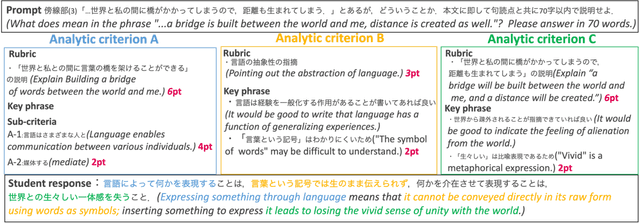
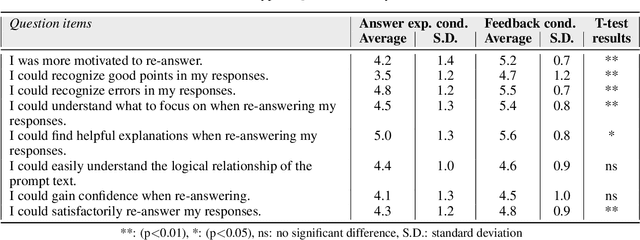
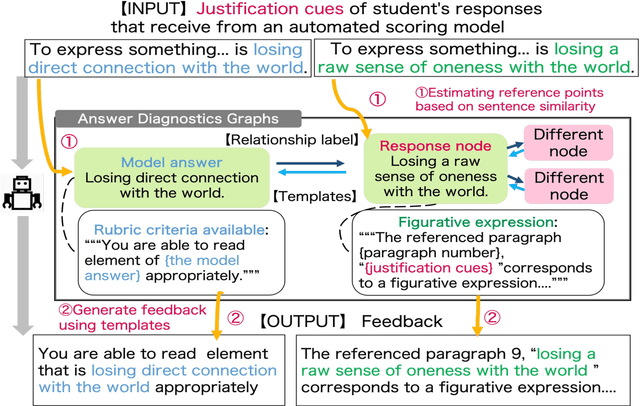

Abstract:Short-reading comprehension questions help students understand text structure but lack effective feedback. Students struggle to identify and correct errors, while manual feedback creation is labor-intensive. This highlights the need for automated feedback linking responses to a scoring rubric for deeper comprehension. Despite advances in Natural Language Processing (NLP), research has focused on automatic grading, with limited work on feedback generation. To address this, we propose a system that generates feedback for student responses. Our contributions are twofold. First, we introduce the first system for feedback on short-answer reading comprehension. These answers are derived from the text, requiring structural understanding. We propose an "answer diagnosis graph," integrating the text's logical structure with feedback templates. Using this graph and NLP techniques, we estimate students' comprehension and generate targeted feedback. Second, we evaluate our feedback through an experiment with Japanese high school students (n=39). They answered two 70-80 word questions and were divided into two groups with minimal academic differences. One received a model answer, the other system-generated feedback. Both re-answered the questions, and we compared score changes. A questionnaire assessed perceptions and motivation. Results showed no significant score improvement between groups, but system-generated feedback helped students identify errors and key points in the text. It also significantly increased motivation. However, further refinement is needed to enhance text structure understanding.
Can Language Models Induce Grammatical Knowledge from Indirect Evidence?
Oct 08, 2024Abstract:What kinds of and how much data is necessary for language models to induce grammatical knowledge to judge sentence acceptability? Recent language models still have much room for improvement in their data efficiency compared to humans. This paper investigates whether language models efficiently use indirect data (indirect evidence), from which they infer sentence acceptability. In contrast, humans use indirect evidence efficiently, which is considered one of the inductive biases contributing to efficient language acquisition. To explore this question, we introduce the Wug InDirect Evidence Test (WIDET), a dataset consisting of training instances inserted into the pre-training data and evaluation instances. We inject synthetic instances with newly coined wug words into pretraining data and explore the model's behavior on evaluation data that assesses grammatical acceptability regarding those words. We prepare the injected instances by varying their levels of indirectness and quantity. Our experiments surprisingly show that language models do not induce grammatical knowledge even after repeated exposure to instances with the same structure but differing only in lexical items from evaluation instances in certain language phenomena. Our findings suggest a potential direction for future research: developing models that use latent indirect evidence to induce grammatical knowledge.
Rationale-Aware Answer Verification by Pairwise Self-Evaluation
Oct 07, 2024Abstract:Answer verification identifies correct solutions among candidates generated by large language models (LLMs). Current approaches typically train verifier models by labeling solutions as correct or incorrect based solely on whether the final answer matches the gold answer. However, this approach neglects any flawed rationale in the solution yielding the correct answer, undermining the verifier's ability to distinguish between sound and flawed rationales. We empirically show that in StrategyQA, only 19% of LLM-generated solutions with correct answers have valid rationales, thus leading to an unreliable verifier. Furthermore, we demonstrate that training a verifier on valid rationales significantly improves its ability to distinguish valid and flawed rationale. To make a better verifier without extra human supervision, we introduce REPS (Rationale Enhancement through Pairwise Selection), a method for selecting valid rationales from candidates by iteratively applying pairwise self-evaluation using the same LLM that generates the solutions. Verifiers trained on solutions selected by REPS outperform those trained using conventional training methods on three reasoning benchmarks (ARC-Challenge, DROP, and StrategyQA). Our results suggest that training reliable verifiers requires ensuring the validity of rationales in addition to the correctness of the final answers, which would be critical for models assisting humans in solving complex reasoning tasks.
LLM-jp: A Cross-organizational Project for the Research and Development of Fully Open Japanese LLMs
Jul 04, 2024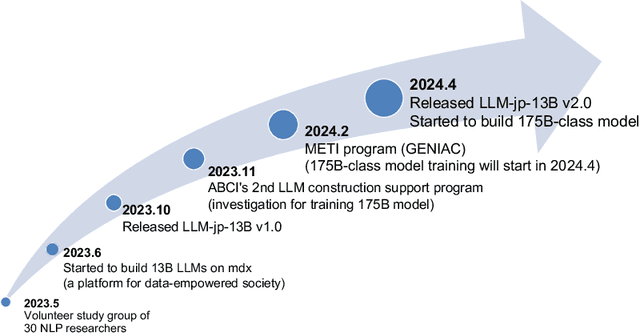
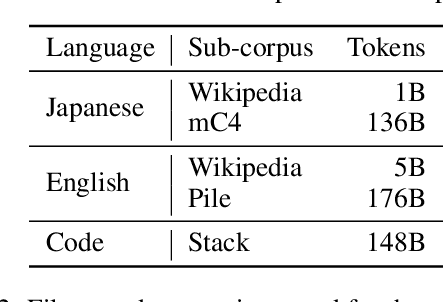


Abstract:This paper introduces LLM-jp, a cross-organizational project for the research and development of Japanese large language models (LLMs). LLM-jp aims to develop open-source and strong Japanese LLMs, and as of this writing, more than 1,500 participants from academia and industry are working together for this purpose. This paper presents the background of the establishment of LLM-jp, summaries of its activities, and technical reports on the LLMs developed by LLM-jp. For the latest activities, visit https://llm-jp.nii.ac.jp/en/.
MoreHopQA: More Than Multi-hop Reasoning
Jun 19, 2024Abstract:Most existing multi-hop datasets are extractive answer datasets, where the answers to the questions can be extracted directly from the provided context. This often leads models to use heuristics or shortcuts instead of performing true multi-hop reasoning. In this paper, we propose a new multi-hop dataset, MoreHopQA, which shifts from extractive to generative answers. Our dataset is created by utilizing three existing multi-hop datasets: HotpotQA, 2WikiMultihopQA, and MuSiQue. Instead of relying solely on factual reasoning, we enhance the existing multi-hop questions by adding another layer of questioning that involves one, two, or all three of the following types of reasoning: commonsense, arithmetic, and symbolic. Our dataset is created through a semi-automated process, resulting in a dataset with 1,118 samples that have undergone human verification. We then use our dataset to evaluate five different large language models: Mistral 7B, Gemma 7B, Llama 3 (8B and 70B), and GPT-4. We also design various cases to analyze the reasoning steps in the question-answering process. Our results show that models perform well on initial multi-hop questions but struggle with our extended questions, indicating that our dataset is more challenging than previous ones. Our analysis of question decomposition reveals that although models can correctly answer questions, only a portion - 38.7% for GPT-4 and 33.4% for Llama3-70B - achieve perfect reasoning, where all corresponding sub-questions are answered correctly. Evaluation code and data are available at https://github.com/Alab-NII/morehopqa
What Makes Language Models Good-enough?
Jun 06, 2024Abstract:Psycholinguistic research suggests that humans may build a representation of linguistic input that is 'good-enough' for the task at hand. This study examines what architectural features make language models learn human-like good-enough language processing. We focus on the number of layers and self-attention heads in Transformers. We create a good-enough language processing (GELP) evaluation dataset (7,680 examples), which is designed to test the effects of two plausibility types, eight construction types, and three degrees of memory cost on language processing. To annotate GELP, we first conduct a crowdsourcing experiment whose design follows prior psycholinguistic studies. Our model evaluation against the annotated GELP then reveals that the full model as well as models with fewer layers and/or self-attention heads exhibit a good-enough performance. This result suggests that models with shallower depth and fewer heads can learn good-enough language processing.
PROPRES: Investigating the Projectivity of Presupposition with Various Triggers and Environments
Dec 14, 2023Abstract:What makes a presupposition of an utterance -- information taken for granted by its speaker -- different from other pragmatic inferences such as an entailment is projectivity (e.g., the negative sentence the boy did not stop shedding tears presupposes the boy had shed tears before). The projectivity may vary depending on the combination of presupposition triggers and environments. However, prior natural language understanding studies fail to take it into account as they either use no human baseline or include only negation as an entailment-canceling environment to evaluate models' performance. The current study attempts to reconcile these issues. We introduce a new dataset, projectivity of presupposition (PROPRES, which includes 12k premise-hypothesis pairs crossing six triggers involving some lexical variety with five environments. Our human evaluation reveals that humans exhibit variable projectivity in some cases. However, the model evaluation shows that the best-performed model, DeBERTa, does not fully capture it. Our findings suggest that probing studies on pragmatic inferences should take extra care of the human judgment variability and the combination of linguistic items.
Evaluating the Rationale Understanding of Critical Reasoning in Logical Reading Comprehension
Nov 30, 2023



Abstract:To precisely evaluate a language model's capability for logical reading comprehension, we present a dataset for testing the understanding of the rationale behind critical reasoning. For questions taken from an existing multiplechoice logical reading comprehension dataset, we crowdsource rationale texts that explain why we should select or eliminate answer options, resulting in 3,003 multiple-choice subquestions that are associated with 943 main questions. Experiments on our dataset show that recent large language models (e.g., InstructGPT) struggle to answer the subquestions even if they are able to answer the main questions correctly. We find that the models perform particularly poorly in answering subquestions written for the incorrect options of the main questions, implying that the models have a limited capability for explaining why incorrect alternatives should be eliminated. These results suggest that our dataset encourages further investigation into the critical reasoning ability of language models while focusing on the elimination process of relevant alternatives.
Probing Physical Reasoning with Counter-Commonsense Context
Jun 04, 2023Abstract:In this study, we create a CConS (Counter-commonsense Contextual Size comparison) dataset to investigate how physical commonsense affects the contextualized size comparison task; the proposed dataset consists of both contexts that fit physical commonsense and those that do not. This dataset tests the ability of language models to predict the size relationship between objects under various contexts generated from our curated noun list and templates. We measure the ability of several masked language models and generative models. The results show that while large language models can use prepositions such as ``in'' and ``into'' in the provided context to infer size relationships, they fail to use verbs and thus make incorrect judgments led by their prior physical commonsense.
 Add to Chrome
Add to Chrome Add to Firefox
Add to Firefox Add to Edge
Add to Edge